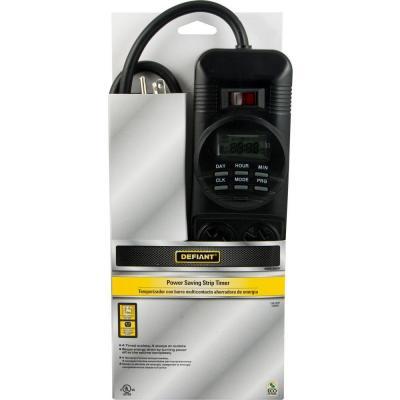Back to Home
By George Odom K4ETN

|
Backup Power index Back to Home |
Backup Power Exerciser By George Odom K4ETN |

|
While assembling my latest repeater project, I realized the need to test and regularly exercise the battery backup function, so I would know that it switches over and operates properly. Not that my site is prone to power failures, but it seemed like a good idea.
So, how to do this? My first thought was to use a programmable timer relay, such as from IDEC, which I have used before, (see us.idec.com/Catalog/ProductFamily.aspx?FamilyName=Timers) and various other available industrial timers.
Like most hams, I look for the best deal on what I am doing. Why would you spend lots of money on an industrial relay when there is an alternative solution out there?
So I searched for "Timers". I have found that it is helpful to look at images of what you search for and then go from there. Lo and behold, a power strip with a programmable seven-day timer from the Home Depot! And the price is only $19.95! It was available at my local store and just a short drive away.
This power strip is made by Defiant and is well constructed. The seven day, seven events per day timer is easy to program and the timer uses a lithium battery as backup. A heavy-duty four-foot AC power cable is also a nice feature. [Editor's note: you could buy other timer strips that only have 24 hour programmability if that's all you need.]
The timer controls four of the eight outlets; the other four are always active. A master power switch controls power for the entire strip. The strip is rated for 15 amps total. This suited my needs perfectly.

Programming:
Setting the strip up on the bench, I plugged in a powered USB hub just to have an indicator of the on/off functions once programmed. It took me a minute to realize that this strip was designed to turn lighting in your home on and off. The timed relay is normally open. Aha! That means that you have to turn the timed outlets ON before you can turn them OFF. Once past this small issue and understanding that the first entry is to turn the timed outlets on, power was supplied to the USB hub (use whatever device you wish as an indicator).
There is a manual that comes with the strip and is well written and easy to understand. It may take a couple of times through to get the hang of programming the timer. The single-page instruction sheet can be viewed here.
Installation:
Several thoughts came to mind during this. The first was trying my best for a neat professional installation.
My system is rack mounted so there were a couple of good options. Having the power strip on the rear of the rack would be nice and clean, but what if I needed access to the timer controls? Front mounting seemed to solve that issue. A two-unit blank rack panel that I had in the shop was perfect for the job.
The easiest way to mount the strip was to mark the slotted hole locations on the rear of the unit then install small sheet metal screws to the proper depth. This allows the strip to slide onto the screws for mounting but can be easily removed for replacement or servicing. Click on the photo for a larger view.
I installed a one-unit ventilation panel under the timed power strip with one vent slat cut out, through which I passed all the equipment power cords to the rear of the rack. Click on the photo for a larger view.
The results are shown here. Now my repeater system exercises the battery backup bank every morning at 9:00am for a period of 30 minutes and returns to line power with no intervention on my part. Testing is performed at this time so local operators can determine the coverage area on low power.
The repeater is a Kenwood TKR850 with an outboard TPL amplifier. When running on batteries, the repeater is switched to a second channel where it can run at lower power. A small 1.5A unit charges the amplifier's battery; the repeater has its own charger built in. The power strip controls the AC power feeding the repeater and amplifier, and relays switch to battery power upon the loss of AC power.
Contact Information:
The author can be contacted at: his-callsign [ at ] comcast [ dot ] net.
Back to the top of the page
Backup Power index
Back to Home
This page written 10-Mar-15 and first posted 10-Mar-15.
Artistic layout and HTML © Copyright 2015 by Robert W. Meister WA1MIK.
Photographs were taken by the author.
This web page, this web site, the information presented in and on its pages and in these modifications and conversions is © Copyrighted 1995 and (date of last update) by Kevin Custer W3KKC and multiple originating authors. All Rights Reserved, including that of paper and web publication elsewhere.